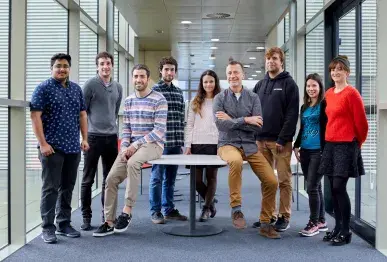CIC nanoGUNE launches a new disruptive technology that allows for a safer delivery of babies
The Nanoengineering Group at nanoGUNE has developed a new technology that allows for non-invasive and continuous monitoring of physiological risks of babies during labour in real time. The technology helps obstetricians take fast decisions, and hence, reduce the worldwide increasing number of cesareans.

Worldwide, the number of newborn deaths counts for 4 million, of which 23% are caused by perinatal asphyxia. The decision for cesarean delivery is mostly based on an invasive pH and lactate blood test that is done by fetal blood scalp sampling during delivery. As current method works discontinuously and an excessively high measurement time is required, a considerable number of failures does occur. The rate of cesareans is considerably high, while the number of adverse neonatal outcomes remains unchanged. Despite World Health Organization’s (WHO) recommendation of not exceeding the rate of 15% . The WHO also states that caesarean section rates higher than 10% are not associated with reductions in maternal and newborn mortality rates, quite the contrary.
“Our technology is based on the combination of Raman spectroscopy, equipped with application-specific probes, and multiparametric machine learning algorithms that take into account the systemic picture of physiological variations or anomalies, compared to state-of-the-art, where a single parameter, as pH or lactate, serves as base for decision-making”, explains Andreas Seifert, Group Leader in the Nanoengineering Group at nanoGUNE . “Raman spectroscopy is a highly specific vibrational spectroscopy method —he continues— and can detect changes of biochemical parameters directly or indirectly. Using machine learning anfor cesarean cuts, the world average stands at around 22%, even rising to 40% in several countriesd considering the entirety of biochemical changes, results in a much more sensitive and stable classification of pathological states and prediction of specific parameters associated to perinatal asphyxia”. “With our technology —adds Andreas Seifert— cesareans and health risks during delivery could be minimized along with the associated administrative costs and social and legal implications”.
Ion Olaetxea, whose PhD thesis is within the framework of the project development, puts emphasize on the innovative and distinctive characteristics of the technology: “We do not find direct competitors. Non-invasive, real-time and continuous monitoring provides us a tangible competitive edge that allows us to differ from current diagnostic methods”.
The idea of perinatal risk monitoring was born in an ongoing joint project, which started in 2017, with the Basque Health Research Institute Biodonostia and involves a multidisciplinary team of physicists, biologists, chemists, biomedical engineers and obstetricians. The work plan includes the development of an optical device and specific software for data analysis; moreover, systematic in vivo and in vitro experiments complement the development. As stated by Ainara Garcia, Technology Transfer Manager at nanoGUNE, “the technology is now protected through a patent application and presents a good readiness level making it appealing for business angels”. “We are receiving calls of interest from venture capitals who are attracted by our technology“, she adds. In addition, “the technology has been awarded in the initial stage of the BBK Venture Philanthropy program — the BBK Venture Philanthropy program aims to promote entrepreneurship and investment with social and environmental impact in Biscay— and it shows that the market is ready to absorb alternatives to conventional methods”, explains Garcia. “Both mothers and babies will directly benefit during labour from our developments” emphasizes the Technology Transfer Manager at nanoGUNE.
“Apart from its application in obstetric care, the technology has high potential for many other disease patterns, as for example sepsis, fatigue, cancer, or infectious diseases. Even in sporting goods industry, particularly competitive sports, we see great chances of applicability”, affirms Andreas Seifert. “By changing the optomechanical design of the Raman probe and developing new classification and regression models, application-specific solutions can be realized”, he adds.
